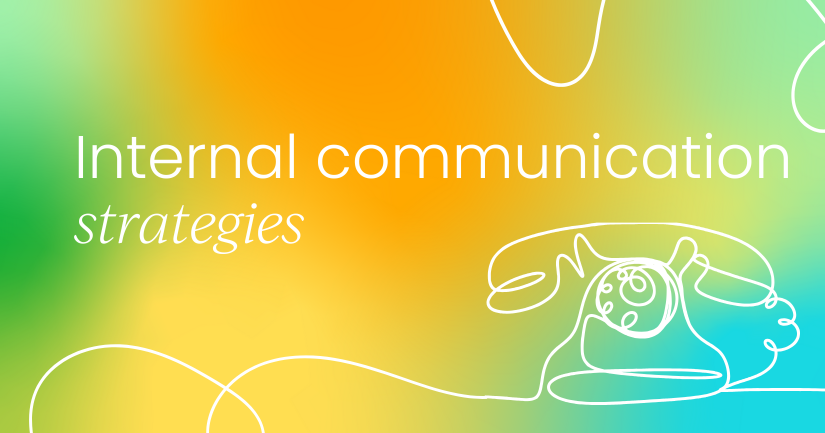Keeping everyone in the loop isn’t an easy task. It’s not as simple as sending a quick memo or update behind a faceless email. Nowadays, you’ve got to create a strong and secure internal communication strategy that focuses on real, open, and effective communication.
A huge chunk of the workforce – nearly three out of four employees (74%) - feel disconnected from important company updates due to the absence of an internal communication strategy. This gap can lead to poor morale, confusion, disengagement, and a lack of alignment with company goals.
When people don't know what's going on, they can't be fully engaged. They can't contribute their best ideas, and they can't feel like a true part of the team. When companies prioritize clear and consistent communication, they empower their workforce, boost morale, and drive overall business success.
So, if you're ready to build a workplace where everyone feels informed and connected, you're in the right place. Below, we’ll look at some of the most effective internal communication strategies to help you create a more transparent, engaged, and productive work environment.
Topics covered:
- Goals of an internal communication strategy
- Key steps and elements
- Effective internal communication strategies
- Internal communication vs. HR communication
What to accomplish with your internal communication strategy
A solid internal communication strategy helps to ensure your company speaks with one clear voice.
Bottom line: your team needs to get two things. Where the company is headed and how they'll fit into making it happen.
This is especially important during times of change when internal messaging must align with what employees see externally (such as on social media or in the press). If your internal and external communications don’t match, trust and clarity will take a hit.
So, what’s the game plan?
1. Tie every message to business goals.
2. Help employees see the bigger picture and their role in it.
3. Ensure communication drives real action.
But before you can develop the actual internal or HR communication plan, there are some questions you need answers to. According to the University of Oxford, these include:
- Are employees getting the right information?
- How often are employees receiving updates?
- Is messaging clear and consistent across the team?
- Do employees understand both the goals and outcomes of communication?
To answer these questions, you can start with a departmental audit. This will help pinpoint any possible challenges that may arise during the process.

Key steps and elements of an internal communications plan
A well-structured internal communications plan ensures staff are well-informed, engaged, and aligned with company goals. It helps businesses communicate effectively, reduce misunderstandings, and build a strong company culture.
Below, we’ll explore the key elements of a great internal communications plan and the steps to create one that works:
Where you are now
The first step is to look at where your internal communication strategy is now. Although you might not realize it, you likely have a communications strategy already in place.
Yes, it might lack structure or coordination, but knowing where you’re at right now is the only way to know if you’re actually making progress later. It doesn’t matter if you're starting from scratch or fine-tuning a well-oiled machine.
What matters is... what are you going to do with what you've got from this point forward?
Clear objectives
Your communication should have a clear purpose. So, take time to define what you want to achieve with this plan, whether it’s improving employee engagement, keeping teams informed, or increasing transparency.
An example might be, "Improve employee understanding of company goals by 30% over the next six months."
Target audience consideration
Different employee groups have different communication needs. Identify who you’re communicating with - executives, managers, frontline workers, or remote employees - and tailor messages to each.
Key messages
What do you want employees to know, feel, or do after receiving your message? Keep messages clear, concise, and aligned with company values.
Communication channels
Choose the right platforms based on your workforce’s preferences. Common channels include email, Slack/Teams, newsletters, etc.
A mix of channels works best. Some employees prefer emails, while others engage more with video messages or chats.
Frequency & timing
Determine how often messages should be sent and when they’ll be most effective. Regular updates keep employees engaged without overwhelming them.
Feedback mechanisms
Two-way communication is crucial. Allow employees to share thoughts, ask questions, and provide feedback through surveys, Q&As, or meetings.

Effective internal communication strategies (and how to implement them)
A strong internal communication strategy keeps employees informed, engaged, and aligned with company goals.
McKinsey & Company reports that employee productivity increases by 20-25% in companies where employees feel connected. When communication flows seamlessly, teams collaborate better, make faster decisions, and stay motivated.
So, how do you create a workplace where everyone feels informed and engaged?
Below are some of the most effective internal communication strategies, how they work, and practical tips for implementing them:
1. Multi-channel communication
One of the easier strategies on this list is a simple multi-channel communication approach which involves using different platforms (emails, Slack, intranet, meetings, newsletters, etc.) to ensure messages reach everyone most effectively. It's about meeting people where they are, with the information they need, in a way that works for them.
How it works: Not all employees consume information the same way. Some prefer quick Slack updates, while others rely on emails or company-wide meetings. By using multiple channels, you increase the chances of getting your message across to everyone, no matter their preference.
Implementation tips:
- Identify which platforms your team prefers.
- Use a mix of real-time (chat tools, meetings) and asynchronous (emails, newsletters) communication.
- Keep messaging consistent across all channels.
2. Leadership transparency & regular updates
Alright, let's talk about something that can really make or break a company's culture: leadership transparency. It's not just about sharing information; it's about building trust and creating a sense of shared purpose.
Winning senior leaders over and having them support your HR communications strategy (or internal comms plan) is critical. Of course, this is often easier said than done.
“Support isn’t just getting it agreed by the management team and then you going off and delivering it. It’s making the strategy integral to the success of the organization.” (source: Government Communication Service)
If you’re facing some resistance, try to show them how your internal communications strategy links to the company’s business strategy and highlight how it’ll help support and deliver on those areas.
How it works: When leadership is transparent, trust grows. Employees feel included in the bigger picture and are more likely to stay engaged and motivated.
Implementation tips:
- Schedule regular meetings or video messages from executives.
- Create an “Ask Me Anything” (AMA) session where employees can submit anonymous questions.
- Share company performance, upcoming changes, and strategic goals in a clear, jargon-free way.
3. Two-way communication & feedback loops
It's not enough to broadcast information - you need to create a dialogue. Think of it this way... if you're only sending messages, you're missing half the picture. You don't know if people understand what you're saying, if they have questions, or if they have valuable insights to share. That's where two-way communication comes in.
How it works: Employees should feel heard, not just spoken to. A two-way system helps management address concerns before they become bigger issues.
Implementation tips:
- Use surveys or anonymous feedback tools.
- Implement open-door policies where employees feel safe voicing concerns.
- Act on feedback—acknowledge issues and follow up with solutions.
Once you've taken action on feedback, let people know what you've done. This shows that you're listening and that their input matters.
4. Personalized & role-based communication
Think about your own experience. How often do you get emails or messages that feel completely irrelevant to your job? It's frustrating, right? That's what happens with one-size-fits-all communication. People tune out when they're bombarded with information that doesn't apply to them.
A great internal communications strategy example is using tailored messages to different teams or individuals based on their roles and needs.
How it works:
Instead of blasting one-size-fits-all messages, personalize content so it’s relevant to specific teams or job functions.
Implementation tips:
- Segment communication by department or role.
- Use automation tools to personalize newsletters and updates.
- Keep technical messages targeted to those who need them.
5. Employee advocacy & recognition
Who do you trust more – a company's marketing message or a recommendation from a friend or colleague?
Employees are your most authentic brand ambassadors. When they feel valued and appreciated, they're more likely to share their positive experiences with others, both inside and outside the company.
This type of approach to internal communications works because it not only celebrates employees’ contributions but encourages them to be brand ambassadors too. It's about creating a culture where recognition is genuine, frequent, and meaningful.
When employees feel valued, they’re more likely to promote the company culture, boosting morale and retention.
Implementation tips:
- Publicly recognize achievements in meetings, newsletters, or internal social platforms.
- Create a peer-to-peer recognition program.
- Encourage employees to share their company experiences on LinkedIn and social media.
Some other approaches
Interactive & visual communication: Using videos, infographics, and interactive platforms instead of just text-heavy emails.
Mobile-first communication: Ensuring internal communication is accessible via mobile devices.
Crisis communication plan: A structured plan for communicating effectively during emergencies or major organizational changes.
Different organizations require different approaches, but a good internal communication strategy is always a mix of multiple methods.
By implementing the right mix of these strategies, you can build a stronger, more engaged workforce where everyone feels informed, connected, and valued. 🚀

Internal communication vs. HR communication: What’s the difference?
While internal communication and HR communication often overlap, they serve distinct purposes within an organization.
Think of HR communication as the "need to know" stuff. Like, "Hey, here's the new parental leave policy," or "Remember, open enrollment for benefits is next week." It's about making sure everyone knows the rules, the perks, and what's expected of them. Basically, it's the stuff that keeps you compliant and makes sure everyone's got the basics covered.
Now, internal communication? That's the bigger picture. It's about building a real connection with your team. It's about making sure everyone understands why they're doing what they're doing, how their work fits into the company's goals, and how the company's values play out in their day-to-day. It's about creating a sense of "we're all in this together."
For example:
- HR says: "New parental leave policy is here!" (Just the facts, ma'am.)
- Internal comms says: "Here's the new parental leave policy, and here's how it reflects our commitment to supporting working families." (Telling the story behind the policy.)
See the difference? HR is more about the "what," and internal comms is more about the "why."
Join us at Chief People Officer Summit
Join us in Silicon Valley on April 30, 2025, for an exclusive gathering of people experts to unlock strategies that will allow you to elevate employee experiences, drive workforce transformation and enable C-suite peers to become the best leadership team.
We’re bringing together people leaders for a day of unrivaled networking, learning, and discussion so you can:
- Build connections with your peers and grow your network C-Suite contacts
- Accelerate workforce transformation and upskill your org in the age of AI
- Understand your strategic value in unlocking growth through effective resource planning



 Follow us on LinkedIn
Follow us on LinkedIn



